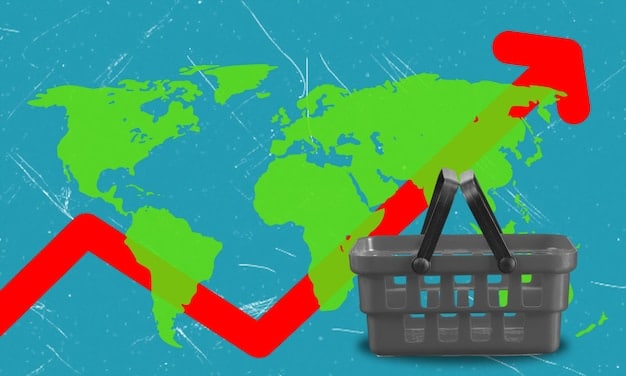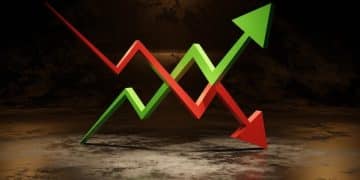Consumer Spending Drop: Is the US Economy Facing a Slowdown?

Financial News: Consumer Spending Declines by 0.5%, raising concerns about a potential economic slowdown in the US, prompting economists and policymakers to analyze the factors contributing to this decrease and its potential impact on future economic growth.
The latest Financial News: Consumer Spending Declines by 0.5% – Is the Economy Slowing Down? This drop has sparked widespread discussion among economists and investors alike, prompting questions about the overall health and future trajectory of the US economy.
Consumer Spending Decline: A Cause for Concern?
The recent **Financial News: Consumer Spending Declines by 0.5%** has brought attention to the possibility of an economic slowdown. Understanding the significance of consumer spending is essential to grasping the implications of this decline.
The Role of Consumer Spending in the US Economy
Consumer spending is a critical driver of economic growth in the United States. It accounts for a significant portion of the country’s gross domestic product (GDP), influencing production, investment, and employment.
Factors Influencing Consumer Spending
Several factors can impact consumer spending, including income levels, employment rates, consumer confidence, interest rates, and inflation. Changes in these factors can directly affect consumers’ willingness and ability to spend.

Recent Trends in Consumer Spending
Over the past few months, there have been indications of a slowdown in consumer spending. Let’s consider some recent trends:
- Decline in Retail Sales: Retail sales have experienced a noticeable decrease in recent months, suggesting that consumers are cutting back on discretionary purchases.
- Shift in Spending Patterns: Consumers are shifting their spending towards essential goods and services, such as groceries and utilities, and away from non-essential items like entertainment and travel.
- Increased Savings Rate: The savings rate has been increasing, indicating that consumers are becoming more cautious and prefer to save rather than spend.
In conclusion, the decline in consumer spending raises concerns about the overall health of the US economy. Monitoring these trends and understanding their potential implications will be crucial for policymakers and businesses alike.
Analyzing the 0.5% Drop: What Does It Mean?
The **Financial News: Consumer Spending Declines by 0.5%** is more than just a statistic; it represents real changes in consumer behavior and can have tangible impacts on various sectors of the economy.
Breaking Down the Numbers
A 0.5% decline in consumer spending may seem small, but it is important to consider the scale of the US economy. This decrease reflects a significant reduction in overall consumer expenditure.
Sector-Specific Impacts
The decline in consumer spending is not uniform across all sectors. Some sectors may be more heavily impacted than others. For example:
- Retail Sector: Retailers, especially those selling non-essential goods, are likely to experience lower sales and potentially face challenges in managing inventory.
- Hospitality and Tourism: The hospitality and tourism sectors, including hotels, restaurants, and airlines, may see a decrease in demand as consumers cut back on travel and leisure activities.
- Manufacturing: Manufacturers may experience a decline in orders as retailers reduce their inventory levels in response to lower consumer demand.

Potential Implications for Economic Growth
The decline in consumer spending can have a ripple effect throughout the economy, potentially leading to slower economic growth. Reduced consumer spending can lead to:
- Lower GDP Growth: Consumer spending is a major component of GDP, so a decrease in spending can directly impact overall economic growth.
- Increased Unemployment: Businesses may be forced to reduce their workforce in response to lower demand, leading to higher unemployment rates.
- Decreased Investment: Businesses may postpone or cancel investment plans due to uncertainty about future demand, further dampening economic growth.
In summary, the 0.5% decline in consumer spending is a significant event that warrants careful analysis. Understanding the sector-specific impacts and potential implications for economic growth is crucial for businesses and policymakers alike.
Interest Rates and Consumer Behavior
Interest rates play a pivotal role in influencing consumer behavior, particularly when it comes to borrowing and spending. The **Financial News: Consumer Spending Declines by 0.5%** may be linked to changes in interest rates.
The Impact of Interest Rates on Borrowing
Higher interest rates make borrowing more expensive, which can discourage consumers from taking out loans for big-ticket items like cars, homes, and appliances. This can lead to a decrease in overall consumer spending.
How Interest Rates Affect Savings
Conversely, higher interest rates can encourage consumers to save more, as they can earn a higher return on their savings. This can also lead to a decrease in consumer spending, as people are more inclined to save rather than spend.
The Federal Reserve’s Role
The Federal Reserve (the Fed) plays a critical role in setting interest rates in the United States. The Fed can raise or lower interest rates in response to changes in economic conditions, such as inflation and unemployment.
The Fed often uses interest rate adjustments to influence consumer behavior and stimulate or slow down economic growth. For example, during times of economic recession, the Fed may lower interest rates to encourage borrowing and spending.
In contrast, during periods of high inflation, the Fed may raise interest rates to reduce borrowing and spending and bring inflation under control.
In conclusion, interest rates have a significant impact on consumer behavior, influencing borrowing, saving, and spending decisions. And the **Financial News: Consumer Spending Declines by 0.5%** may be a direct result of interest rate policies implemented by the Federal Reserve.
Inflation and its Impact on Consumer Spending
Inflation, the rate at which the general level of prices for goods and services is rising, also has a significant impact on the purchasing power of consumers. To understand the **Financial News: Consumer Spending Declines by 0.5%** fully, we need to consider the role of inflation.
Understanding Inflation
Inflation erodes the value of money over time, meaning that consumers can buy less with the same amount of money. This can lead to a decrease in consumer spending, as people become more cautious about their purchases.
The Relationship Between Inflation and Consumer Behavior
When inflation is high, consumers may cut back on discretionary spending and focus on essential goods and services. This can lead to a decrease in overall consumer spending and potentially slow down economic growth.
Measuring Inflation: The Consumer Price Index (CPI)
The Consumer Price Index (CPI) is a widely used measure of inflation in the United States. It tracks the average change over time in the prices paid by urban consumers for a basket of consumer goods and services.
The CPI is used by policymakers, economists, and businesses to monitor inflation trends and make informed decisions. For instance, if the CPI is rising rapidly, the Federal Reserve may take measures to curb inflation, such as raising interest rates.
Consumers and businesses can track the CPI to understand the impact of inflation on their purchasing power. This information can then be used to inform their decisions about spending, saving, and investing.
To summarize, inflation has a significant impact on consumer spending. By understanding the relationship between inflation and consumer behavior, one can better interpret the **Financial News: Consumer Spending Declines by 0.5%**.
The Impact of Global Economic Factors
The US economy is interconnected with the global economy. Global economic factors, such as international trade and economic conditions in other countries, can also influence consumer spending in the United States. Because of this interconnection, the **Financial News: Consumer Spending Declines by 0.5%** may or may not be directly caused by factors inside of the US borders.
The Role of International Trade
International trade plays a significant role in the US economy, accounting for a substantial portion of the country’s GDP. Changes in international trade patterns can impact consumer spending in several ways.
The United States imports a wide variety of consumer goods from other countries. If the cost of these imports increases, due to factors such as tariffs or exchange rate fluctuations, consumers may have to pay higher prices, leading to a decrease in consumer spending.
Conversely, if the cost of imports decreases, consumers may be able to buy more goods and services, leading to an increase in consumer spending. This could result in a more robust economic environment.
Global Economic Conditions
Economic conditions in other countries can also impact consumer spending in the United States. For example, if a major trading partner experiences an economic slowdown, this can lead to a decrease in demand for US exports.
This decrease in demand can negatively impact US businesses and result in layoffs, leading to a decrease in consumer spending. Furthermore, uncertainty about global economic conditions can lead consumers to become more cautious about their spending habits.
By understanding the impact of global economic factors on consumer spending, businesses and policymakers can make informed decisions about trade policies, investments, and economic strategies.
What Could Happen: Future Economic Scenarios
Given the **Financial News: Consumer Spending Declines by 0.5%**, it is important to consider potential future economic scenarios. There are several possible outcomes, each with its own implications for businesses and consumers.
Scenario 1: Moderate Economic Growth
In this scenario, consumer spending stabilizes and gradually returns to its previous growth rate. This could be driven by a combination of factors, such as:
- Increased consumer confidence
- Lower interest rates
- Government stimulus measures
Under this scenario, businesses would likely experience moderate growth in sales and profits, and the economy would continue to expand at a sustainable pace. This “Goldilocks” scenario would be ideal.
Scenario 2: Economic Slowdown
In this scenario, consumer spending continues to decline, leading to a more pronounced economic slowdown. This could be caused by factors such as:
- Rising interest rates or inflation
- Increased unemployment
- Decreased consumer confidence
IUnder this scenario, businesses would likely experience lower sales and profits, and the economy could potentially enter a recession.
Scenario 3: Recovery and Growth
In this scenario, consumer spending rebounds strongly, leading to a period of rapid economic growth. This could be triggered by unforeseen factors that dramatically change consumer behavior. Strong stimulus packages and rapid technological innovations could foster such as recovery and growth spurt.
Under this scenario, businesses would likely experience significant growth in sales and profits, and the economy would expand at a rapid pace.
In short, understanding the range of potential future economic scenarios is crucial for businesses and policymakers. By considering the potential outcomes and their associated implications, businesses can make better-informed decisions about their strategies, investments, and operations.
| Key Point | Brief Description |
|---|---|
| 📉 Spending Decline | Consumer spending dropped by 0.5%, raising economic concerns. |
| 💸 Interest Rates | Higher rates can reduce spending and increase savings. |
| 🌍 Global Factors | International trade and global economics influence US spending. |
| 🔮 Economic Scenarios | Potential outcomes: moderate growth, slowdown, or recovery. |
Frequently Asked Questions
▼
A 0.5% decline suggests a decrease in the amount people are spending on goods and services, which can indicate a weakening economy. It reflects changing consumer behavior.
▼
Higher interest rates make borrowing more expensive, which can discourage consumers from making large purchases. Lower rates can encourage spending by making loans more affordable.
▼
The CPI measures the average change over time in the prices paid by urban consumers for a basket of goods and services. It is a key indicator of inflation.
▼
Global economic conditions, like trade policies and international recessions, can impact the cost of imports, demand for US exports, and overall consumer sentiment, influencing spending habits stateside.
▼
Possible scenarios include moderate growth, continued economic slowdown, or a rebound leading to rapid growth. The actual outcome depends on multiple factors affecting consumer behavior.
Conclusion
In conclusion, the **Financial News: Consumer Spending Declines by 0.5%** is a multifaceted issue with several potential implications for the US economy. Understanding the roles of interest rates, inflation, global economic conditions, and consumer behavior is essential for assessing the future trajectory of the economy. By monitoring these factors closely and making informed decisions, businesses and individuals can better navigate the challenges and opportunities that lie ahead.





